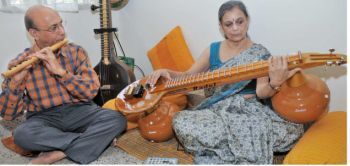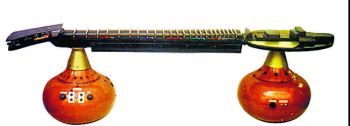Digital Revolution in Indian Music
– Ranjani Govind

Bangalore: G. Raj Narayan and Radhika Raj Narayan of Radel Electronics at an interview with The Hindu on October, 26, 2010. (pic to go with Ranjani Govind’s story) Photo: V Sreenivasa Murthy.
Radel has become an integral part of the music scene. Colourful red-cedar and plywood guitars with German silver frets among other instruments grab one’s attention at G. Raj Narayan’s house in Bangalore. “I made this guitar with my own hands,” he says, explaining his family’s penchant for making musical devices themselves! More known as Radel Raj Narayan in the musicians’ fraternity, this electrical engineer is an acclaimed classical flautist, and has been the brain behind Radel’s unusual line of products that has brought in electronic substitutes for traditional musical instruments.
Today, there is no Carnatic or Hindustani musician who isn’t using a Radel product either on stage or during practice sessions. From transistor technology based-ones to the latest micro-controller-based designed ones with embedded software, Raj Narayan has in the past three decades released 18 electronic versions that are constantly upgraded.
Radel has bagged the National Award of Special Recognition for Research and Development by the Government of India recently. Radel’s range of electronic models has legends such as Pt. Ravi Shankar, Dr. Balamuralikrishna and Ustad Amjad Ali Khan appreciating ‘the handy technology’ and has proved to be a revolutionary endeavour for the music world.
While Radel’s’ electronic veena is considered something unique, the digital version is the first Indian instrument to be awarded a patent by the Indian Patent office in 2002. Raj Narayan presents concerts with wife and vainika Radhika who is a support in all of Radel’s electronic adventures.
Q: So when did the voyage begin?
A: “I was exposed to both Carnatic and Hindustani music during my childhood in New Delhi,” says Raj Narayan. “My mother Sugandha Raman used to perform Carnatic vocal and veena concerts regularly. My father was a mechanical engineer, one of the first few Indians to go for higher studies in the 1930s to Germany. A flautist himself, he had many hobbies and had a workshop at home where he stored equipment of all sorts, from masonry to carpentry.”
After graduating in electrical engineering, Raj Narayan joined HAL in 1968 as a trainee. There he was exposed to the latest technology. After 10 years, he quit HAL to start Radel.

Q: What led him to creating electronic-devices for musicians?
A: Explains Raj Narayan: “In all my practice sessions at home I would need someone to keep sruti and tala. My mother and Radhika would help but not always. Initially I contemplated a simple device that could help my flute practice without someone playing the sruti box or tambura.
“My father had devised a mechanical contraption that had him move the bellows of the conventional sruti box with his knee, but that did not suit extended sessions. The R&D lab of HAL-aerospace industry had kindled my electronic interest so I got to work on transistorised circuits in 1970, and came up with one that provided the three adjustable notes Sa-Pa-Sa that had stability of pitch acceptable to musicians.”
According to the entrepreneur, the instrument was demonstrated at a music conference in Bangalore in 1971 and Prof. T.R. Subramaniam grabbed it for his U.S. tour, and that was the start of the musical instrument revolution.